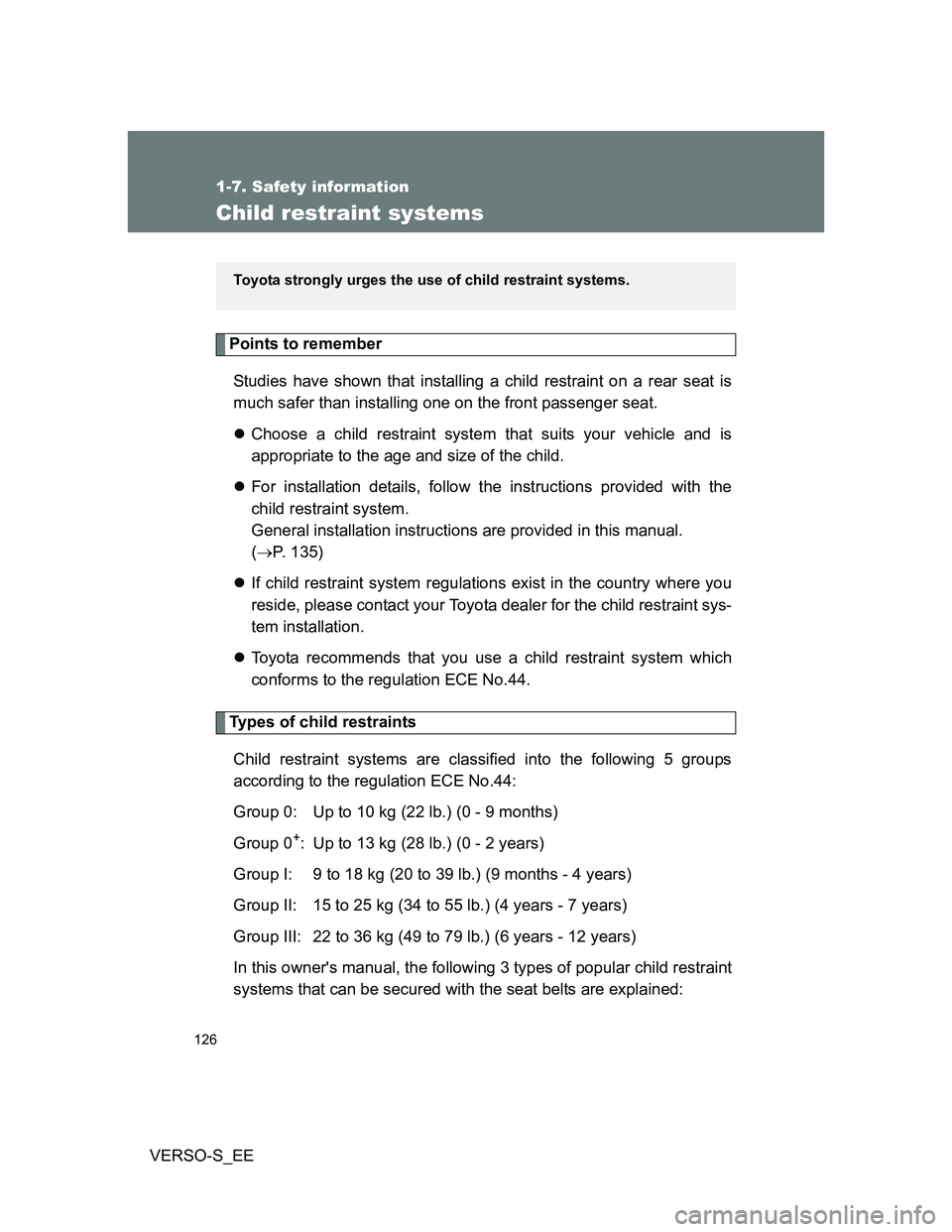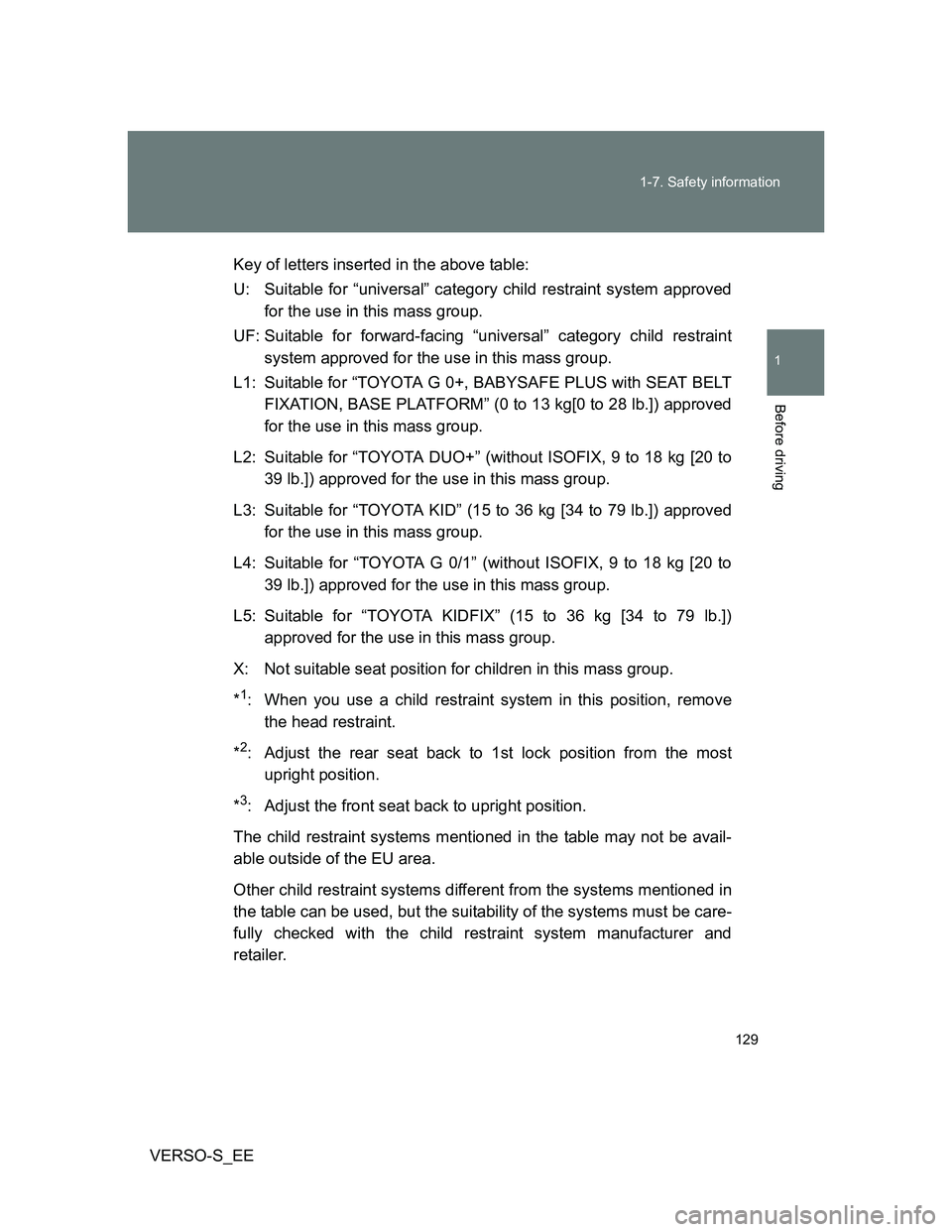Page 126 of 552

126
1-7. Safety information
VERSO-S_EE
Child restraint systems
Points to remember
Studies have shown that installing a child restraint on a rear seat is
much safer than installing one on the front passenger seat.
Choose a child restraint system that suits your vehicle and is
appropriate to the age and size of the child.
For installation details, follow the instructions provided with the
child restraint system.
General installation instructions are provided in this manual.
(P. 135)
If child restraint system regulations exist in the country where you
reside, please contact your Toyota dealer for the child restraint sys-
tem installation.
Toyota recommends that you use a child restraint system which
conforms to the regulation ECE No.44.
Types of child restraints
Child restraint systems are classified into the following 5 groups
according to the regulation ECE No.44:
Group 0: Up to 10 kg (22 lb.) (0 - 9 months)
Group 0
+: Up to 13 kg (28 lb.) (0 - 2 years)
Group I: 9 to 18 kg (20 to 39 lb.) (9 months - 4 years)
Group II: 15 to 25 kg (34 to 55 lb.) (4 years - 7 years)
Group III: 22 to 36 kg (49 to 79 lb.) (6 years - 12 years)
In this owner's manual, the following 3 types of popular child restraint
systems that can be secured with the seat belts are explained:
Toyota strongly urges the use of child restraint systems.
Page 129 of 552

129 1-7. Safety information
1
Before driving
VERSO-S_EEKey of letters inserted in the above table:
U: Suitable for “universal” category child restraint system approved
for the use in this mass group.
UF: Suitable for forward-facing “universal” category child restraint
system approved for the use in this mass group.
L1: Suitable for “TOYOTA G 0+, BABYSAFE PLUS with SEAT BELT
FIXATION, BASE PLATFORM” (0 to 13 kg[0 to 28 lb.]) approved
for the use in this mass group.
L2: Suitable for “TOYOTA DUO+” (without ISOFIX, 9 to 18 kg [20 to
39 lb.]) approved for the use in this mass group.
L3: Suitable for “TOYOTA KID” (15 to 36 kg [34 to 79 lb.]) approved
for the use in this mass group.
L4: Suitable for “TOYOTA G 0/1” (without ISOFIX, 9 to 18 kg [20 to
39 lb.]) approved for the use in this mass group.
L5: Suitable for “TOYOTA KIDFIX” (15 to 36 kg [34 to 79 lb.])
approved for the use in this mass group.
X: Not suitable seat position for children in this mass group.
*
1: When you use a child restraint system in this position, remove
the head restraint.
*
2: Adjust the rear seat back to 1st lock position from the most
upright position.
*
3: Adjust the front seat back to upright position.
The child restraint systems mentioned in the table may not be avail-
able outside of the EU area.
Other child restraint systems different from the systems mentioned in
the table can be used, but the suitability of the systems must be care-
fully checked with the child restraint system manufacturer and
retailer.
Page 132 of 552

132 1-7. Safety information
VERSO-S_EE
Selecting an appropriate child restraint system
Use a child restraint system appropriate for the child until the child
becomes large enough to properly wear the vehicle’s seat belt.
If the child is too large for a child restraint system, sit the child on a rear
seat and use the vehicle's seat belt. (P. 77)
CAUTION
Using a child restraint system
The use of a child restraint system not suitable for the vehicle may not prop-
erly secure the infant or child. It may result in death or serious injury (in the
event of sudden braking or an accident).
Child restraint precautions
For effective protection in automobile accidents and sudden stops, a child
must be properly restrained, using a seat belt or child restraint system
depending on the age and size of the child. Holding a child in your arms is
not a substitute for a child restraint system. In an accident, the child can be
crushed against the windshield, or between you and the vehicle's interior.
Toyota strongly urges the use of a proper child restraint system that con-
forms to the size of the child, installed on the rear seat. According to acci-
dent statistics, the child is safer when properly restrained in the rear seat
than in the front seat.
Page 134 of 552
134 1-7. Safety information
VERSO-S_EE
CAUTION
When children are in the vehicle
Do not allow children to play with the seat belt. If the seat belt becomes
twisted around a child’s neck, choking or other serious injuries may result in
death.
If this occurs and the buckle cannot be unfastened, scissors should be used
to cut the belt.
When the child restraint system is not in use
Keep the child restraint system properly secured on the seat even if it is
not in use. Do not store the child restraint system unsecured in the pas-
senger compartment.
If it is necessary to detach the child restraint system, remove it from the
vehicle or store it securely in the luggage compartment. This will prevent it
from injuring passengers in the event of a sudden stop, sudden swerve or
accident.
Page 135 of 552
135
1
1-7. Safety information
Before driving
VERSO-S_EE
Installing child restraints
Follow the child restraint system manufacturer's instructions. Firmly
secure child restraints to the seats using a seat belt or ISOFIX rigid
anchors. Attach the top strap when installing a child restraint.
Seat belts (An ELR belt
requires a locking clip.)
ISOFIX rigid anchors (ISOFIX
child restraint system)
Lower anchors are provided for
the outer rear seats. (Tags dis-
playing the location of the
anchors are attached to the
seats.)
Anchor brackets (for the top
strap)
An anchor bracket is provided
for the outer rear seats.
Page 136 of 552
136 1-7. Safety information
VERSO-S_EE
Installing child restraints using a seat belt
Rear facing Baby seat/child seat
1st lock position
2nd lock position
Fold the seatback forward and
then back to the 1st lock position
(most upright position) until it
locks into place. Adjust the seat-
back to the 2nd lock position.
(P. 7 0 )
Place the child restraint system
on the rear seat facing the rear
of the vehicle.
Run the seat belt through the
child restraint system and insert
the plate into the buckle. Make
sure that the belt is not twisted.
STEP1
STEP2
STEP3
Page 137 of 552
137 1-7. Safety information
1
Before driving
VERSO-S_EEInstall a locking clip near the tab
of the lap and shoulder belt by
inserting the lap and shoulder
webbing through the recesses of
the locking clip.
Forward facing Child seat
1st lock position
2nd lock position
Fold the seatback forward and
then back to the 1st lock position
(most upright position) until it
locks into place. Adjust the seat-
back to the 2nd lock position.
(P. 7 0 )
Depending on the type of the
child restraint system and its
seating position, remove the
head restraint of the seat.
(P. 128)
Place the child restraint system
on the seat facing the front of the
vehicle.
STEP4
STEP1
STEP2
STEP3
Page 138 of 552
138 1-7. Safety information
VERSO-S_EERun the seat belt through the
child restraint system and insert
the plate into the buckle. Make
sure that the belt is not twisted.
Install a locking clip near the tab
of the lap and shoulder belt by
inserting the lap and shoulder
webbing through the recesses of
the locking clip.
Junior seat
1st lock position
2nd lock position
Fold the seatback forward and
then back to the 1st lock position
(most upright position) until it
locks into place. Adjust the seat-
back to the 2nd lock position.
(P. 7 0 )
Depending on the type of the
child restraint system and its
seating position, remove the
head restraint of the seat.
(P. 128)
STEP4
STEP5
STEP1
STEP2